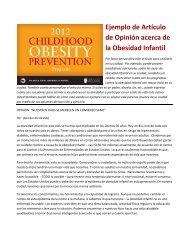Writing Proposals for HIV/AIDS Prevention Grants - U.S. Conference ...
Writing Proposals for HIV/AIDS Prevention Grants - U.S. Conference ...
Writing Proposals for HIV/AIDS Prevention Grants - U.S. Conference ...
Create successful ePaper yourself
Turn your PDF publications into a flip-book with our unique Google optimized e-Paper software.
4 TECHNICAL ASSISTANCE REPORTS March 2003entitled “Demonstrating <strong>HIV</strong> Risk When Limited DataExist on Your Target Population.”It is much easier to write the Executive Summary after allthe other parts of the proposal have been completed.At that point in the writing process, the details of theproposed program will be much clearer.• The name and description of the applicant organization,including a statement about why the applicant is qualifiedto do the proposed work.• The target population.• A brief statement of the problem or need the proposaladdresses.• A short description of the proposed project, includingthe main objectives, the key program components andactivities, the methods or approaches used, and theexpected outcomes.• Amount of funding requested.2. Problem StatementThe purpose of the Problem Statementis to show why the proposedprogram is needed.This section is often referred to as the ProblemStatement, Statement of Need, Justification of Need, orNeeds Assessment. Regardless of the name used, the purposeis the same: to convince the reviewer, through a presentationof supporting evidence and persuasive argument,that a compelling problem exists in your community thatcan be effectively addressed by your proposed program.Below are suggestions <strong>for</strong> areas that can be covered inthe Problem Statement. Deciding what in<strong>for</strong>mation toinclude will ultimately depend on the requirements ofthe funding source, the nature of the problem and thetarget population, and the in<strong>for</strong>mation available to theproposal writer. Most of the in<strong>for</strong>mation discussed belowis already available in your local, regional, or state <strong>HIV</strong>prevention plan developed through the communityplanning process. For ideas on how to gather <strong>HIV</strong> riskin<strong>for</strong>mation from other sources, see the box on page 6Definition of Target PopulationReviewers need to know as clearly as possible whoyour proposed program will serve. Given that all groupsof people are not at equal risk <strong>for</strong> <strong>HIV</strong>, it is important tobe as specific as possible in terms of race/ethnicity, specificrisk behavior(s), age, socioeconomic background, andgeographic area. Being specific demonstrates that yourorganization has a clear understanding of the risk behaviorsand needs of your target population and has defined the partof that population that it can reasonably expect to reach.Don’t say that your program will target “AfricanAmerican women in the Bronx.” After all, all AfricanAmerican women in the Bronx are not at risk <strong>for</strong> <strong>HIV</strong>and there are far too many at-risk African Americanwomen in the Bronx to be effectively reached by a singleprogram. A better way to specify a target population is tosay you will target “African American women betweenthe ages of 18-30 who live in the following areas of theBronx [insert the names of specific neighborhoods or zipcodes] and who are at risk <strong>for</strong> <strong>HIV</strong> because they abuse drugsand/or exchange sex <strong>for</strong> money, drugs, or resources.”Defining your target population as narrowly as possible willhelp you identify gaps in existing services <strong>for</strong> that populationand make a better case <strong>for</strong> why your program is needed.Impact of <strong>HIV</strong>/<strong>AIDS</strong> on Target PopulationYour discussion should include in<strong>for</strong>mation on thenature and extent of the <strong>HIV</strong>/<strong>AIDS</strong> problem in the targetpopulation. Discuss briefly how <strong>HIV</strong>/<strong>AIDS</strong> has affectedthe target population. How many people in the targetpopulation are infected with <strong>HIV</strong>, how many have<strong>AIDS</strong>, and how many have died of <strong>AIDS</strong>? What are theepidemiological trends that relate to your target population?The data you use should be as local as possible. Evenwhen epidemiological evidence is strong, you can addspecific examples from your organization’s own experienceto help reviewers visualize the situation. For example, ifyour organization recently provided <strong>HIV</strong> testing in a localbar to 30 Latino men who have sex with men (MSM)and several tested positive, tell reviewers about this(while protecting the clients’ identities).The United States <strong>Conference</strong> of Mayors • 1620 Eye Street,NW • Washington, DC 20006 • (202) 293-7330www.usmayors.org/uscm











